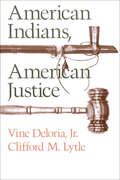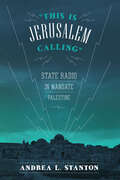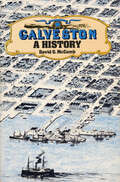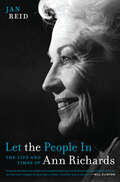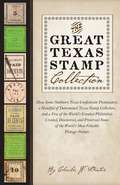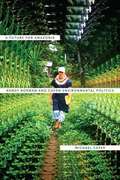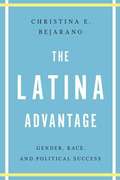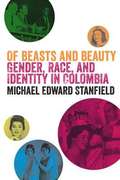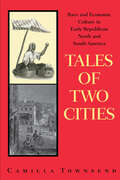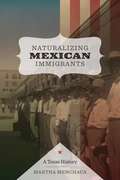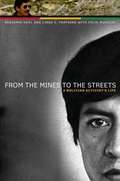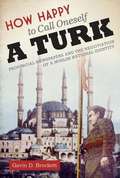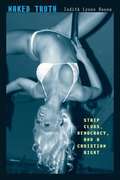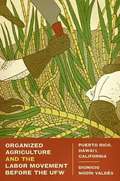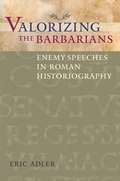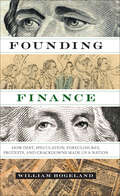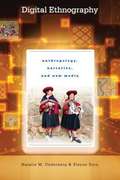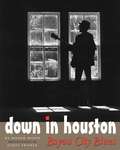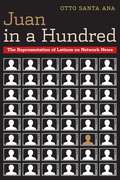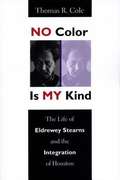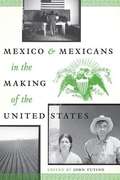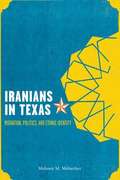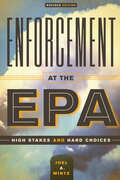- Table View
- List View
American Indians, American Justice
by Clifford M. Lytle Deloria VineThis comprehensive overview of federal Indian law explores the context and complexities of modern Native American politics and legal rights.Both accessible and authoritative, American Indians, American Justice is an essential sourcebook for all concerned with the plight of the contemporary Indian. Beginning with an examination of the historical relationship of Indians and the courts, the authors describe how tribal courts developed and operate today, and how they relate to federal and state governments. They also define such key legal concepts as tribal sovereignty and Indian Country. By comparing and contrasting the workings of Indian and non-Indian legal institutions, the authors illustrate how Indian tribes have adapted their customs, values, and institutions to the demands of the modern world. They examine how attorneys and Indian advocates defend Indian rights; identify the typical challenges Indians face in the criminal and civil legal arenas; and explore the public policy and legal rights of Indians as regards citizenship, voting rights, religious freedom, and basic governmental services.
"This Is Jerusalem Calling": State Radio in Mandate Palestine
by Andrea L. StantonModeled after the BBC, the Palestine Broadcasting Service was launched in 1936 to serve as the national radio station of Mandate Palestine, playing a pivotal role in shaping the culture of the emerging middle class in the region. <P><P>Despite its significance, the PBS has become nearly forgotten by scholars of twentieth-century Middle Eastern studies. Drawn extensively from British and Israeli archival sources, “This Is Jerusalem Calling” traces the compelling history of the PBS’s twelve years of operation, illuminating crucial aspects of a period when Jewish and Arab national movements simultaneously took form.
Galveston: A History (Fred Rider Cotten Popular History Ser. #15)
by David G. McCombA colorful history of the island city on Texas&’s Gulf Coast and its survival through times of piracy, plague, civil war, and devastating natural disaster. On the Gulf edge of Texas between land and sea stands Galveston Island. Shaped continually by wind and water, it is one of earth&’s ongoing creations, where time is forever new. Here, on the shoreline, embraced by the waves, a person can still feel the heartbeat of nature. And yet, for all the idyllic possibilities, Galveston&’s history has been anything but tranquil. Across Galveston&’s sands have walked Indians, pirates, revolutionaries, the richest men of nineteenth-century Texas, soldiers, sailors, bootleggers, gamblers, prostitutes, physicians, entertainers, engineers, and preservationists. Major events in the island&’s past include hurricanes, yellow fever, smuggling, vice, the Civil War, the building of a medical school and port, raids by the Texas Rangers, and, always, the struggle to live in a precarious location. Galveston: A History is an engrossing account that also explores the role of technology and the often contradictory relationship between technology and the city, providing a guide to both Galveston history and the dynamics of urban development.
Let the People In: The Life and Times of Ann Richards
by Jan ReidWhen Ann Richards delivered the keynote of the 1988 Democratic National Convention and mocked President George H. W. Bush—“Poor George, he can’t help it. He was born with a silver foot in his mouth”—she instantly became a media celebrity and triggered a rivalry that would alter the course of American history. In 1990, Richards won the governorship of Texas, upsetting the GOP’s colorful rancher and oilman Clayton Williams. The first ardent feminist elected to high office in America, she opened up public service to women, blacks, Hispanics, Asian Americans, gays, and the disabled. Her progressive achievements and the force of her personality created a lasting legacy that far transcends her rise and fall as governor of Texas. In Let the People In, Jan Reid draws on his long friendship with Richards, interviews with her family and many of her closest associates, her unpublished correspondence with longtime companion Bud Shrake, and extensive research to tell a very personal, human story of Ann Richards’s remarkable rise to power as a liberal Democrat in a conservative Republican state. Reid traces the whole arc of Richards’s life, beginning with her youth in Waco, her marriage to attorney David Richards, her frustration and boredom with being a young housewife and mother in Dallas, and her shocking encounters with Lyndon Johnson and Jimmy Carter. He follows Richards to Austin and the wild 1970s scene and describes her painful but successful struggle against alcoholism. He tells the full, inside story of Richards’s rise from county office and the state treasurer’s office to the governorship, where she championed gun control, prison reform, environmental protection, and school finance reform, and he explains why she lost her reelection bid to George W. Bush, which evened his family’s score and launched him toward the presidency. Reid describes Richards’s final years as a world traveler, lobbyist, public speaker, and mentor and inspiration to office holders, including Hillary Clinton. His nuanced portrait reveals a complex woman who battled her own frailties and a good-old-boy establishment to claim a place on the national political stage and prove “what can happen in government if we simply open the doors and let the people in. ”
The Great Texas Stamp Collection
by Charles W. DeatonAmong the many difficulties the newly formed Confederate States of America endured in the summer of 1861 was the failure of its post office department to provide sufficient numbers of that item most crucial to its service: the postage stamp. Faced with the resulting din of customer complaints, a handful of industrious Texas postmasters solved the problem by simply making their own homemade stamps. In this thoroughly researched history of these rare and highly coveted stamps, The Great Texas Stamp Collection traces their journey from creation through their rediscovery years later by local, and then international, stamp collectors-a journey that culminated in the sale of a few pieces at a recent auction in New York that fetched more than $250,000. Weaving the larger contexts of Texas and U. S. postal history together with individual tales of greed, intrigue, forgery, and discovery, Deaton's book is rich with characters from European royalty to early stamp dealers to common criminals, while also providing detailed examinations of the stamps themselves, including a complete census of the stamps now known as the Texas Confederate Postmasters' Provisionals. Appealing at once to devoted philatelists, Texas and U. S. history buffs, and amateur collectors of all kinds, The Great Texas Stamp Collection offers a unique vantage point from which to view our history as well as the very nature of collecting.
A Future for Amazonia: Randy Borman and Cofán Environmental Politics
by Michael CepekBlending ethnography with a fascinating personal story, A Future for Amazonia is an account of a political movement that arose in the early 1990s in response to decades of attacks on the lands and peoples of eastern Ecuador, one of the world's most culturally and biologically diverse places. <P><P>After generations of ruin at the hands of colonizing farmers, transnational oil companies, and Colombian armed factions, the indigenous Cofán people and their rain forest territory faced imminent jeopardy. In a surprising turn of events, the Cofán chose Randy Borman, a man of Euro-American descent, to lead their efforts to overcome the crisis that confronted them.
The Latina Advantage: Gender, Race, and Political Success
by Christina E. BejaranoDuring the past decade, racial/ethnic minority women have made significant strides in U. S. politics, comprising large portions of their respective minority delegations both in Congress and in state legislatures. This trend has been particularly evident in the growing political presence of Latinas, yet scholars have offered no clear explanations for this electoral phenomenon--until now. In The Latina Advantage, Christina E. Bejarano draws on national public opinion datasets and a close examination of state legislative candidates in Texas and California to demonstrate the new power of the political intersection between race and gender. Underscoring the fact that racial/ethnic minority women form a greater share of minority representatives than do white women among white elected officials, Bejarano provides empirical evidence to substantiate previous theoretical predictions of the strategic advantage in the intersectionality of gender and ethnicity in Latinas. Her evidence indicates that two factors provide the basis for the advantage: increasingly qualified candidates and the softening of perceived racial threat, leading minority female candidates to encounter fewer disadvantages than their male counterparts. Overturning the findings of classic literature that reinforce stereotypes and describe minority female political candidates as being at a compounded electoral disadvantage, Bejarano brings a crucial new perspective to dialogues about the rapidly shifting face of America's electorate.
Of Beasts and Beauty: Gender, Race, and Identity in Colombia
by Michael Edward StanfieldAll societies around the world and through time value beauty highly. Tracing the evolutions of the Colombian standards of beauty since 1845, Michael Edward Stanfield explores their significance to and symbiotic relationship with violence and inequality in the country. Arguing that beauty holds not only social power but also economic and political power, he positions it as a pacific and inclusive influence in a country “ripped apart by violence, private armies, seizures of land, and abuse of governmental authority, one hoping that female beauty could save it from the ravages of the male beast. ” One specific means of obscuring those harsh realities is the beauty pageant, of which Colombia has over 300 per year. Stanfield investigates the ways in which these pageants reveal the effects of European modernity and notions of ethnicity on Colombian women, and how beauty for Colombians has become an external representation of order and morality that can counter the pathological effects of violence, inequality, and exclusion in their country.
Tales of Two Cities: Race and Economic Culture in Early Republican North and South America
by Camilla TownsendParallel histories of workers in two port cities, Baltimore and Guayaquil, illustrate divergent paths in the development of the Americas. The United States and the countries of Latin America were all colonized by Europeans, yet in terms of economic development, the U.S. far outstripped Latin America beginning in the nineteenth century. Observers have often tried to account for this disparity, many of them claiming that differences in cultural attitudes toward work explain the US&’s greater prosperity. In this innovative study, however, Camilla Townsend challenges the traditional view that North Americans succeeded because of the so-called Protestant work ethic—and argues instead that they prospered relative to South Americans because of differences in attitudes towards workers that evolved in the colonial era. Townsend builds her study around workers&’ lives in two similar port cities in the 1820s and 1830s. Through the eyes of the young Frederick Douglass in Baltimore, Maryland, and an Indian girl named Ana Yagual in Guayaquil, Ecuador, she shows how differing attitudes toward race and class in North and South America affected local ways of doing business. This empirical research clarifies the significant relationship between economic culture and racial identity—and its long-term effects.
Naturalizing Mexican Immigrants
by Martha MenchacaDuring the nineteenth and early twentieth centuries, a majority of the Mexican immigrant population in the United States resided in Texas, making the state a flashpoint in debates over whether to deny naturalization rights. As Texas federal courts grappled with the issue, policies pertaining to Mexican immigrants came to reflect evolving political ideologies on both sides of the border. Drawing on unprecedented historical analysis of state archives, U. S. Congressional records, and other sources of overlooked data, Naturalizing Mexican Immigrants provides a rich understanding of the realities and rhetoric that have led to present-day immigration controversies. Martha Menchaca's groundbreaking research examines such facets as U. S. -Mexico relations following the U. S. Civil War and the schisms created by Mexican abolitionists; the anti-immigration stance that marked many suffragist appeals; the effects of the Spanish American War; distinctions made for mestizo, Afromexicano, and Native American populations; the erosion of means for U. S. citizens to legalize their relatives; and the ways in which U. S. corporations have caused the political conditions that stimulated emigration from Mexico. The first historical study of its kind, Naturalizing Mexican Immigrants delivers a clear-eyed view of provocative issues.
The Berber Identity Movement and the Challenge to North African States
by Bruce Maddy-WeitzmanLike many indigenous groups that have endured centuries of subordination, the Berber/Amazigh peoples of North Africa are demanding linguistic and cultural recognition and the redressing of injustices. Indeed, the movement seeks nothing less than a refashioning of the identity of North African states, a rewriting of their history, and a fundamental change in the basis of collective life. In so doing, it poses a challenge to the existing political and sociocultural orders in Morocco and Algeria, while serving as an important counterpoint to the oppositionist Islamist current. This is the first book-length study to analyze the rise of the modern ethnocultural Berber/Amazigh movement in North Africa and the Berber diaspora. Bruce Maddy-Weitzman begins by tracing North African history from the perspective of its indigenous Berber inhabitants and their interactions with more powerful societies, from Hellenic and Roman times, through a millennium of Islam, to the era of Western colonialism. He then concentrates on the marginalization and eventual reemergence of the Berber question in independent Algeria and Morocco, against a background of the growing crisis of regime legitimacy in each country. His investigation illuminates many issues, including the fashioning of official national narratives and policies aimed at subordinating Berbers in an Arab nationalist and Islamic-centered universe; the emergence of a counter-movement promoting an expansive Berber “imagining” that emphasizes the rights of minority groups and indigenous peoples; and the international aspects of modern Berberism.
From the Mines to the Streets
by Benjamin Kohl Linda Farthing Félix MuruchiFrom the Mines to the Streets draws on the life of Félix Muruchi to depict the greater forces at play in Bolivia and elsewhere in South America during the last half of the twentieth century. It traces Félix from his birth in an indigenous family in 1946, just after the abolition of bonded labor, through the next sixty years of Bolivia’s turbulent history. As a teenager, Félix followed his father into the tin mines before serving a compulsory year in the military, during which he witnessed the 1964 coup d’état that plunged the country into eighteen years of military rule. He returned to work in the mines, where he quickly rose to become a union leader. The reward for his activism was imprisonment, torture, and exile. After he came home, he participated actively in the struggles against neoliberal governments, which led in 2006—the year of his sixtieth birthday—to the inauguration of Evo Morales as Bolivia’s first indigenous president. The authors weave Muruchi’s compelling recollections with contextual commentary that elucidates Bolivian history. The combination of an unforgettable life story and in-depth text boxes makes this a gripping, effective account, destined to become a classic sourcebook.
How Happy to Call Oneself a Turk
by Gavin D. BrockettThe modern nation-state of Turkey was established in 1923, but when and how did its citizens begin to identify themselves as Turks? Mustafa Kemal Ataturk, Turkey's founding president, is almost universally credited with creating a Turkish national identity through his revolutionary program to "secularize" the former heartland of the Ottoman Empire. Yet, despite Turkey's status as the lone secular state in the Muslim Middle East, religion remains a powerful force in Turkish society, and the country today is governed by a democratically elected political party with a distinctly religious (Islamist) orientation. In this history, Gavin D. Brockett takes a fresh look at the formation of Turkish national identity, focusing on the relationship between Islam and nationalism and the process through which a "religious national identity" emerged. Challenging the orthodoxy that Ataturk and the political elite imposed a sense of national identity from the top down, Brockett examines the social and political debates in provincial newspapers from around the country. He shows that the unprecedented expansion of print media in Turkey between 1945 and 1954, which followed the end of strict, single-party authoritarian government, created a forum in which ordinary people could inject popular religious identities into the new Turkish nationalism. Brockett makes a convincing case that it was this fruitful negotiation between secular nationalism and Islam--rather than the imposition of secularism alone--that created the modern Turkish national identity.
Naked Truth: Strip Clubs, Democracy, and a Christian Right
by Judith Lynne HannaAcross America, strip clubs have come under attack by a politically aggressive segment of the Christian Right. Using plausible-sounding but factually untrue arguments about the harmful effects of strip clubs on their communities, the Christian Right has stoked public outrage and incited local and state governments to impose onerous restrictions on the clubs with the intent of dismantling the exotic dance industry. But an even larger agenda is at work, according to Judith Lynne Hanna. In Naked Truth, she builds a convincing case that the attack on exotic dance is part of the activist Christian Right’s “grand design” to supplant constitutional democracy in America with a Bible-based theocracy. Hanna takes readers onstage, backstage, and into the community and courts to reveal the conflicts, charges, and realities that are playing out at the intersection of erotic fantasy, religion, politics, and law. She explains why exotic dance is a legitimate form of artistic communication and debunks the many myths and untruths that the Christian Right uses to fight strip clubs. Hanna also demonstrates that while the fight happens at the local level, it is part of a national campaign to regulate sexuality and punish those who do not adhere to Scripture-based moral values. Ultimately, she argues, the naked truth is that the separation of church and state is under siege and our civil liberties—free speech, women’s rights, and free enterprise—are at stake.
Organized Agriculture and the Labor Movement before the UFW: Puerto Rico, Hawai'i, California
by Dionicio Nodín ValdésPuerto Rico, Hawai'i, and California share the experiences of conquest and annexation to the United States in the nineteenth century and mass organizational struggles by rural workers in the twentieth. Organized Agriculture and the Labor Movement before the UFW offers a comparative examination of those struggles, which were the era's longest and most protracted campaigns by agricultural workers, supported by organized labor, to establish a collective presence and realize the fruits of democracy.
Valorizing the Barbarians
by Eric AdlerWith the growth of postcolonial theory in recent decades, scholarly views of Roman imperialism and colonialism have been evolving and shifting. Much recent discussion of the topic has centered on the ways in which ancient Roman historians consciously or unconsciously denigrated non-Romans. Similarly, contemporary scholars have downplayed Roman elite anxiety about their empire’s expansion. In this groundbreaking new work, Eric Adler explores the degree to which ancient historians of Rome were capable of valorizing foreigners and presenting criticisms of their own society. By examining speeches put into the mouths of barbarian leaders by a variety of writers, he investigates how critical of the empire these historians could be. Adler examines pairs of speeches purportedly delivered by non-Roman leaders so that the contrast between them might elucidate each writer’s sense of imperialism. Analyses of Sallust’s and Trogus’s treatments of the Eastern ruler Mithradates, Polybius’s and Livy’s speeches from Carthage’s Hannibal, and Tacitus’s and Cassius Dio’s accounts of the oratory of the Celtic warrior queen Boudica form the core of this study. Adler supplements these with examinations of speeches from other characters, as well as contextual narrative from the historians. Throughout, Adler wrestles with broader issues of Roman imperialism and historiography, including administrative greed and corruption in the provinces, the treatment of gender and sexuality, and ethnic stereotyping.
Let the People In: The Life and Times of Ann Richards
by Jan ReidThis intimate biography of the pioneering Texas governor is “required reading for political junkies—and for women considering a life in politics” (Booklist).When Ann Richards delivered the keynote of the 1988 Democratic National Convention and mocked President Bush—“Poor George, he can’t help it. He was born with a silver foot in his mouth”—she became an instant celebrity and triggered a rivalry that would alter the course of history. In 1990, she won the governorship of Texas, becoming the first ardent feminist elected to high office in America. Richards opened pathways for greater diversity in public service, and her achievements created a legacy that transcends her tenure in office.In Let the People In, Jan Reid offers an intimate portrait of Ann Richards’s remarkable rise to power as a liberal Democrat in a deeply conservative state. Reid draws on his long friendship with Richards, as well as interviews with family, personal correspondence, and extensive research to tell the story of Richards’s life, from her youth in Waco, through marriage and motherhood, her struggle with alcoholism, and her shocking encounters with Lyndon Johnson and Jimmy Carter.Reid shares the inside story of Richards’s rise from county office to the governorship, as well as her score-settling loss of the governorship to George W. Bush. Reid also describes Richards’s final years as a mentor to a new generation of public servants, including Hillary Clinton.
Founding Finance: How Debt, Speculation, Foreclosures, Protests, and Crackdowns Made Us a Nation (Discovering America)
by William HogelandThe author of The Whiskey Rebellion “dig[s] beneath history’s surface and note[s] both the populist and anti-populist dimensions of the nation’s founding” (Library Journal).Recent movements such as the Tea Party and anti-tax “constitutional conservatism” lay claim to the finance and taxation ideas of America’s founders, but how much do we really know about the dramatic clashes over finance and economics that marked the founding of America? Dissenting from both right-wing claims and certain liberal preconceptions, Founding Finance brings to life the violent conflicts over economics, class, and finance that played directly, and in many ways ironically, into the hardball politics of forming the nation and ratifying the Constitution—conflicts that still continue to affect our politics, legislation, and debate today.Mixing lively narrative with fresh views of America’s founders, William Hogeland offers a new perspective on America’s economic infancy: foreclosure crises that make our current one look mild; investment bubbles in land and securities that drove rich men to high-risk borrowing and mad displays of ostentation before dropping them into debtors’ prisons; depressions longer and deeper than the great one of the twentieth century; crony mercantilism, war profiteering, and government corruption that undermine any nostalgia for a virtuous early republic; and predatory lending of scarce cash at exorbitant, unregulated rates, which forced people into bankruptcy, landlessness, and working in the factories and on the commercial farms of their creditors. This story exposes and corrects a perpetual historical denial—by movements across the political spectrum—of America’s all-important founding economic clashes, a denial that weakens and cheapens public discourse on American finance just when we need it most.
Digital Ethnography: Anthropology, Narrative, and New Media
by Natalie M. Underberg Elayne ZornDigital ethnography can be understood as a method for representing real-life cultures through storytelling in digital media. Enabling audiences to go beyond absorbing facts, computer-based storytelling allows for immersion in the experience of another culture. A guide for anyone in the social sciences who seeks to enrich ethnographic techniques, Digital Ethnography offers a groundbreaking approach that utilizes interactive components to simulate cultural narratives. Integrating insights from cultural anthropology, folklore, digital humanities, and digital heritage studies, this work brims with case studies that provide in-depth discussions of applied projects. Web links to multimedia examples are included as well, including projects, design documents, and other relevant materials related to the planning and execution of digital ethnography projects. In addition, new media tools such as database development and XML coding are explored and explained, bridging the literature on cyber-ethnography with inspiring examples such as blending cultural heritage with computer games. One of the few books in its field to address the digital divide among researchers, Digital Ethnography guides readers through the extraordinary potential for enrichment offered by technological resources, far from restricting research to quantitative methods usually associated with technology. The authors powerfully remind us that the study of culture is as much about affective traits of feeling and sensing as it is about cognition—an approach facilitated (not hindered) by the digital age.
Art Against Dictatorship: Making and Exporting Arpilleras Under Pinochet
by Jacqueline AdamsArt can be a powerful avenue of resistance to oppressive governments. During the dictatorship of Augusto Pinochet in Chile, some of the country's least powerful citizens-impoverished women living in Santiago's shantytowns-spotlighted the government's failings and use of violence by creating and selling arpilleras, appliquéd pictures in cloth that portrayed the unemployment, poverty, and repression that they endured, their work to make ends meet, and their varied forms of protest. Smuggled out of Chile by human rights organizations, the arpilleras raised international awareness of the Pinochet regime's abuses while providing income for the arpillera makers and creating a network of solidarity between the people of Chile and sympathizers throughout the world. Using the Chilean arpilleras as a case study, this book explores how dissident art can be produced under dictatorship, when freedom of expression is absent and repression rife, and the consequences of its production for the resistance and for the artists. Taking a sociological approach based on interviews, participant observation, archival research, and analysis of a visual database, Jacqueline Adams examines the emergence of the arpilleras and then traces their journey from the workshops and homes in which they were made, to the human rights organizations that exported them, and on to sellers and buyers abroad, as well as in Chile. She then presents the perspectives of the arpillera makers and human rights organization staff, who discuss how the arpilleras strengthened the resistance and empowered the women who made them.
Juan in a Hundred: The Representation of Latinos on Network News
by Otto Santa AnaLatinos constitute the fastest-growing and largest ethnic minority in the United States, yet less than one percent of network news coverage deals with Latinos as the focus of a story. Out of that one percent, even fewer stories are positive in either content or tone. Author of the acclaimed Brown Tide Rising: Metaphors of Latinos in Contemporary American Public Discourse, Otto Santa Ana has completed a comprehensive analysis of this situation, blending quantitative research with semiotic readings and ultimately applying cognitive science and humanist theory to explain the repercussions of this marginal, negative coverage. Santa Ana's choice of network evening news as the foundation for Juan in a Hundred is significant because that medium is currently the single most authoritative and influential source of opinion-generating content. In his 2004 research, Santa Ana calculated that among approximately 12,000 stories airing across four networks (ABC, CBS, CNN, NBC), only 118 dealt with Latinos, a ratio that has remained stagnant over the past fifteen years. Examining the content of the stories, from briefs to features, reveals that Latino-tagged events are apparently only broadcast when national politics or human calamity are involved, and even then, the Latino issue is often tangential to a news story as a whole. On global events involving Latin America, U.S. networks often remain silent while BBC correspondents prepare fully developed, humanizing coverage. The book concludes by demonstrating how this obscurity and misinformation perpetuate maligned perceptions about Latinos. Santa Ana's inspiring calls for reform are poised to change the face of network news in America.
No Color is My Kind: The Life of Eldrewey Stearns and the Integration of Houston
by Thomas R. ColeNo Color Is My Kind is an uncommon chronicle of identity, fate, and compassion as two men--one Jewish and one African American--set out to rediscover a life lost to manic depression and alcoholism. In 1984, Thomas Cole discovered Eldrewey Stearns in a Galveston psychiatric hospital. Stearns, a fifty-two-year-old black man, complained that although he felt very important, no one understood him. Over the course of the next decade, Cole and Stearns, in a tumultuous and often painful collaboration, recovered Stearns' life before his slide into madness--as a young boy in Galveston and San Augustine and as a civil rights leader and lawyer who sparked Houston's desegregation movement between 1959 and 1963. While other southern cities rocked with violence, Houston integrated its public accommodations peacefully. In these pages appear figures such as Thurgood Marshall, Martin Luther King, Jr. , Leon Jaworski, and Dan Rather, all of whom--along with Stearns--maneuvered and conspired to integrate the city quickly and calmly. Weaving the tragic story of a charismatic and deeply troubled leader into the record of a major historic event, Cole also explores his emotionally charged collaboration with Stearns. Their poignant relationship sheds powerful and healing light on contemporary race relations in America, and especially on issues of power, authority, and mental illness.
Mexico and Mexicans in the Making of the United States
by John TutinoMexico and Mexicans have been involved in every aspect of making the United States from colonial times until the present. Yet this shared history is a largely untold story, eclipsed by headlines about illegal immigration and the drug war. Placing Mexicans and Mexico in the centre of American history, this volume elucidates how economic, social, and cultural legacies grounded in colonial New Spain shaped both Mexico and the United States, as well as how Mexican Americans have constructively participated in North American ways of production, politics, social relations, and cultural understandings. Combining historical, sociological, and cultural perspectives, the contributors to this volume explore the following topics: the Hispanic foundations of North American capitalism; indigenous peoples' actions and adaptations to living between Mexico and the United States; U. S. literary constructions of a Mexican "other" during the U. S. -Mexican War and the Civil War; the Mexican cotton trade, which helped sustain the Confederacy during the Civil War; the transformation of the Arizona borderlands from a multiethnic Mexican frontier into an industrializing place of "whites" and "Mexicans"; the early-twentieth-century roles of indigenous Mexicans in organizing to demand rights for all workers; the rise of Mexican Americans to claim middle-class lives during and after World War II; and the persistence of a Mexican tradition of racial/ethnic mixing - mestizaje - as an alternative to the racial polarities so long at the centre of American life.
Iranians in Texas: Migration, Politics, and Ethnic Identity
by Mobasher Mohsen M.Thousands of Iranians fled their homeland when the 1978–1979 revolution ended the fifty-year reign of the Pahlavi Dynasty. Some fled to Europe and Canada, while others settled in the United States, where anti-Iranian sentiment flared as the hostage crisis unfolded. For those who chose America, Texas became the fourth-largest settlement area, ultimately proving to be a place of paradox for any Middle Easterner in exile. Iranians in Texas culls data, interviews, and participant observations in Iranian communities in Houston, Dallas, and Austin to reveal the difficult, private world of cultural pride, religious experience, marginality, culture clashes, and other aspects of the lives of these immigrants. Examining the political nature of immigration and how the originating and receiving countries shape the prospects of integration, Mohsen Mobasher incorporates his own experience as a Texas scholar born in Iran. Tracing current anti-Muslim sentiment to the Iranian hostage crisis, two decades before 9/11, he observes a radically negative shift in American public opinion that forced thousands of Iranians in the United States to suddenly be subjected to stigmatization and viewed as enemies. The book also sheds light on the transformation of the Iranian family in exile and some of the major challenges that second-generation Iranians face in their interactions with their parents. Bringing to life a unique population in the context of global politics, Iranians in Texas overturns stereotypes while echoing diverse voices.
Enforcement at the EPA: High Stakes and Hard Choices, Revised Edition
by Joel A. MintzA former EPA chief attorney traces the tumultuous history of the agency&’s enforcement efforts from the Nixon through the second Bush administrations. Based on 190 personal interviews with present and former enforcement officials at EPA, the U.S. Department of Justice, and key congressional staff members—along with extensive research among EPA documents and secondary sources—this book vividly recounts the often-tumultuous history of EPA&’s enforcement program. It also analyzes some important questions regarding EPA&’s institutional relationships and the Agency&’s working environment. This revised and updated edition adds substantial new chapters examining EPA enforcement during the Clinton and George W. Bush administrations. Its treatment of issues of civil service decline and the applicability of captive agency theory is also new and original. The first published work to treat the historical evolution of EPA enforcement, this book provides a candid inside glimpse of a crucial aspect of the work of an important federal agency. &“Explores the agency&’s strengths and weaknesses . . . With insight and intimate knowledge of enforcement and compliance, Mintz relates an interesting story.&” —Ecology Law Quarterly
